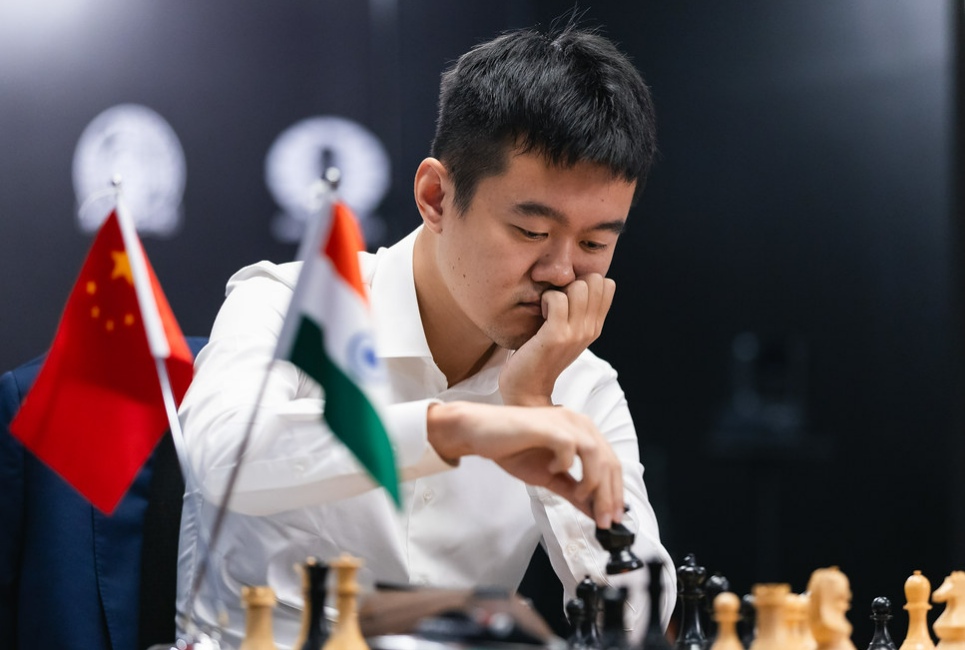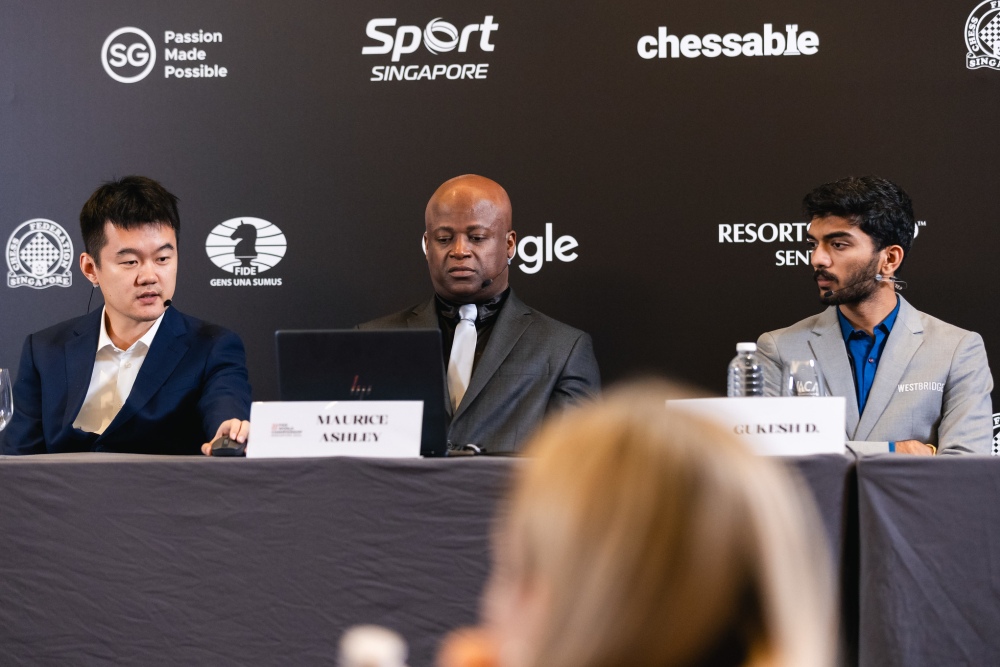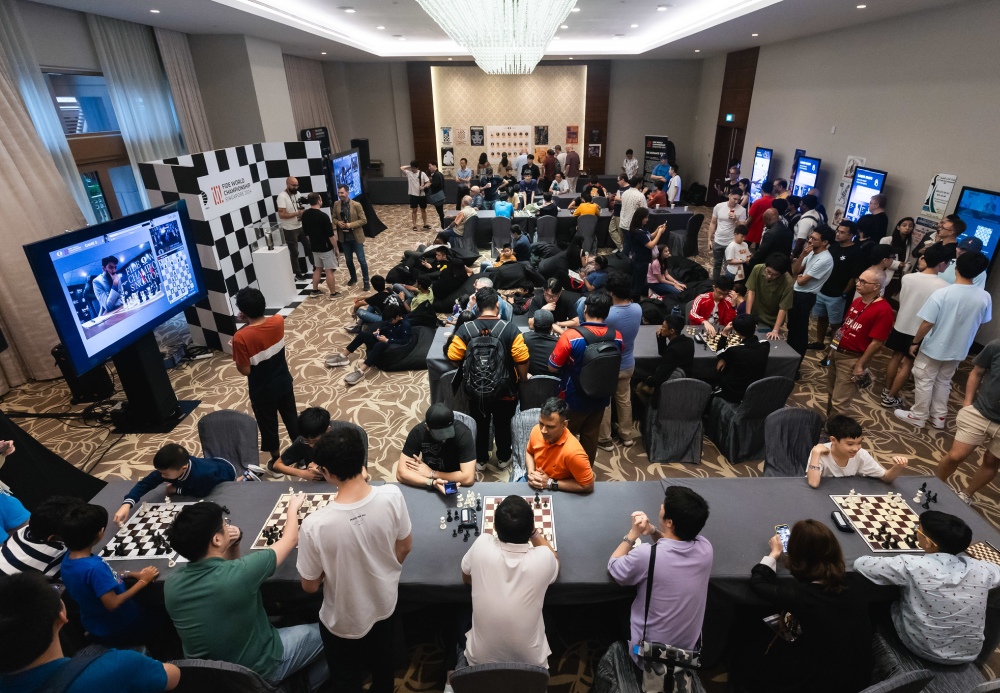
Against all odds, World Champion Ding Liren missed a great chance to pile up the pressure in the FIDE World Championship match presented by Google, misplaying a significant advantage in the endgame.
Defending the black pieces, the Chinese champion efficiently neutralized his opponent’s exchange variation in the French Defence and seemed to be well on his to scoring his second win.
However, just when the time seemed ripe, uncertainty crept in. Ding did not find the strongest continuation in a critical position, allowing the challenger to escape with a draw and keep the score tied at 2.5 points apiece heading into Game 6.

The game started as usual with the customary handshake and ceremonial move. Both players arrived quite a few minutes before 5 PM and were introduced to K. Shanmugam, the Minister for Home Affairs and Minister for Law of Singapore. A passionate chess enthusiast, whose son is actually an International Master, performed the opening move for Gukesh.
Ding Liren chose to repeat the French defence, which gave him such a good result in the first game. Gukesh changed gears and surprisingly decided to play the exchange variation, a line he had never used in his classical games.

Legendary Philippine GM Eugenio Torre, invited guest for commentary, shared his thoughts: “I noticed that the players are trying to play different openings and defences. You used to be able to play the same variations but not anymore because of the computers”.
On move eight, Gukesh introduced a new idea, 8.Qe2+, specially prepared for this game. He was obviously very aware of the main line with 8.0 – 0 since it was played twice in the Toronto Candidates tournament, by both Hikaru Nakamura and Ian Nepomniachtchi against Nijat Abasov. A couple of months later, Nakamura’s second, Nils Grandelius, tested it again without much success in the Budapest Olympiad against Alexei Shirov.

Ding went into the tank for nearly forty minutes considering his options and came up with the best defence, maintaining the equilibrium. Regarding deep thinking, Torre made another interesting observation: “Grandmasters usually only analyse one or two moves ahead, except when there is a forced variation, in which you have to think six or seven moves ahead, for example when you sacrifice a piece.”
After the early exchange of queens, realizing that his opponent was going to equalize the position without many problems, Gukesh decided to play actively with 17.g4, a risky move that he has made in all three of his games with White.

“It’s cool that it’s the third game in a row that I am playing g4,” Gukesh said after the game. However, a few moves later he forgot to exchange the rooks (Gukesh should have played 23.Rxe5) and, without really knowing how, found himself in a very difficult ending.
In the commentary booth, GM David Howell was amazed: “Black’s winning chances have suddenly increased massively. The move 23.dxe5 might have been a big mistake; I would have preferred to exchange rooks. Gukesh didn’t even think about it, he’s got 51 minutes on the clock, but he played it immediately. We often call it “the sting in the tail” – right at the end of a variation sometimes you forget to look one move deeper.”

Put yourself in Ding Liren’s shoes. Should you play 27…Bc6 or 27…Be6?
“Towards the end of the game, I was very worried about my position after the manoeuvre 27…Be6 followed by 28…Rc8. I was quite relieved when my opponent played 27…Bc6, as I thought it would be a draw” a visibly relieved Gukesh explained in the postgame press conference.
The champion acknowledged missing a big opportunity: “I didn’t see the idea with 28…Rc8, I was thinking of moving the king to the kingside, like some kind of Berlin pawn structure. I didn’t realize that it was a big advantage for me.”

On social media, several strong players including the Latvian legend GM Arturs Neiksans were not impressed by Gukesh’s performance.

After Ding missed this one golden opportunity, the position fizzled out into an opposite-side coloured bishop endgame with a totally irrelevant extra pawn for Gukesh – a draw was quickly agreed upon reaching the reglementary move forty threshold.
At the end of the press conference, Gukesh congratulated his colleague teammate Nihal Sarin for his recent success: “I didn’t know that he won the 3rd President Cup in Uzbekistan, so firstly congrats to him. During the tournament, I generally don’t talk to many people outside my team, but it’s always nice when Indian youngsters keep achieving things, it’s motivating for all of us.”

The sixth game of the match is scheduled for Sunday, December 1, at 5 PM local time in Singapore with Ding Liren playing White.
FACT SHEET, Game 5, FIDE World Championship:
White: Gukesh
Black: Ding Liren
Result: 0.5-0.5
Game length: 40 moves
Opening: French Defence
Variation: Exchange variation
Match score: 2.5-2.5
Written by IM Michael Rahal (Singapore)
Photos: Eng Chin An and Maria Emelianova
Official website: worldchampionship.fide.com/
Full programme of side-events: worldchampionship.fide.com/events
About the event
Current World Champion Ding Liren, representing China, and challenger Gukesh D, from India, face each other in a fourteen-game classical chess match. The player who scores 7.5 points or more will win the match, picking up the better part of the $2.5 million total prize fund.
The first of the fourteen scheduled games took place on Monday, November 25 at 5 pm with Gukesh opening with White. Hosted at the luxurious Resorts World Sentosa the match is broadcast live with expert commentary on the FIDE YouTube Channel.


